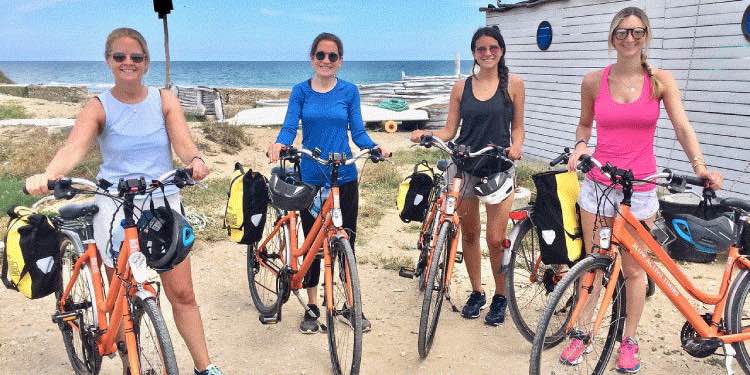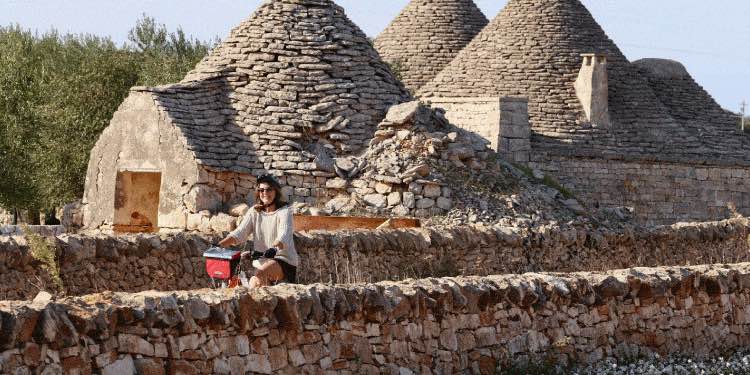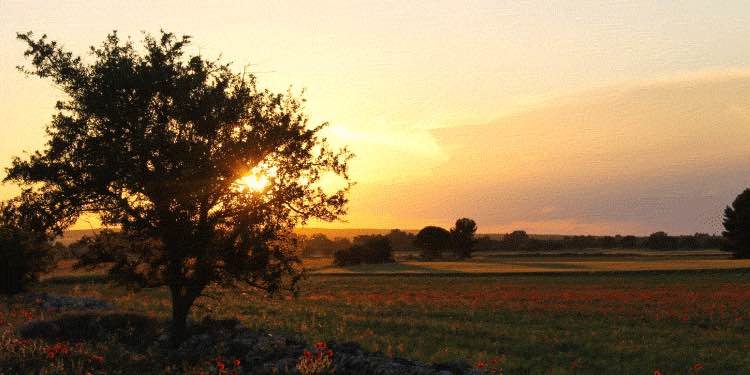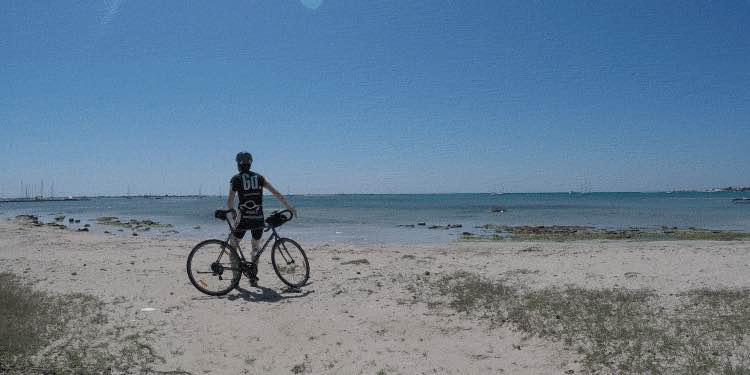The combination of Puglia and bike is becoming increasingly popular among thousands of tourists who every year choose to spend their vacations in the versatile heel of Italy.
The very long Puglia (more than 400km long), with its extraordinary Masseria-farmhouses, along with the nearby and surprising Basilicata, is now among the top destinations for national, European and overseas cycling holidays, almost like Tuscany and its agriturismo.

Why Puglia is a destination for bike tourism
It is already for some years that Puglia has been a renowned destination for national and international cyclists. The reasons are various: the geological conformation of the territory, partly flat and partly hilly; the diversity of landscapes that Puglia, the most eastern region of Italy, offers; good food (for us locals almost obvious); the architectural and artistic variety of our small towns; the slow lifestyle that fascinates and excites cyclists in Puglia; over 800km of coastline, where rocky cliffs alternate with crags and long sandy coasts.
So you can say that there is something for all tastes, but also for all budgets: luxury masserias in the area of Savelletri, where Madonna has put up home and now she can also dance the pizzica, but also many others scattered throughout the territory, even a little more authentic; small hotels tucked away in the alleys of the historic centers; big resorts along the coast that during the low season become resting places on the cycle route; and finally thousands of family-run Bed & Breakfasts everywhere, where hospitality is always at home.
Yet in Puglia there are almost no bike paths, but it really doesn’t matter ... they are replaced by the hundreds of country roads that become real cycle routes, where thousands of olive trees shelter the cyclist from the sun and make everything even nicer.

How to choose cycling routes in Puglia
We know perfectly the maps of Puglia and southern Italy, and for this reason our tours are especially designed.
We choose, whenever possible, the most beautiful bike paths to connect sites and charming towns like Lecce, Matera, Cisternino, Martina Franca, Alberobello, Ostuni, Gallipoli, Leuca, Otranto and many others.

Lecce
It is the Baroque city par excellence, that shines with its white and ductile local stone, known locally as Pietra di Cursi. Between the end of the 16th and the first half of the 18th century the master stonemasons gave vent to their creativity by using this soft stone and so easy to work. They created doodles and floral decorations to embellish and enrich the hundred churches and the many noble palaces that decorate the historic center.
A unique style of Baroque, which is characterized by its character almost purely decorative and never, or almost never, architectural. A soft stone but also surprisingly resistant to atmospheric agents, so much so that the white churches and buildings, after a good 'dusting', seem to come back as new. Even today many local artists wisely work this stone,
and often the stone hides treasures that many times are found by chance, as happened to the Faggiano family, who has discovered and valued an inestimable treasure.
For a cyclist who comes to visit Salento by bike, Lecce becomes almost a logical start and end point for a nice bike tour in the extreme south-eastern tip of Italy.

Matera
How can we not say that Matera is a unique city? It has finally been discovered by the myriad of tourists and cyclists who daily visit it, and who often stay overnight in its characteristic Sassi. Unesco heritage and European Capital of Culture, the city does not lend itself to cycling: Matera is best discovered on foot, going up and down on the enlarged roofs and cisterns hidden in the caves between the Sasso Barisano and the Sasso Caveoso.
Matera is located in the extreme western strip on the Murge plateau, where the river Gravina passes, today just a small stream, but that is thought to have a totally different flow in the past, it dug the deep canyon that takes the same name.
Matera is closely linked to Puglia, from both a historical and tourist point of view. Historically it was part of the Terra d'Otranto, today it’s easy for a cyclist to reach Matera riding a bicycle, or from Matera cycling toward the Alta Murgia or to the milder hills of Itria Valley.

Itria Valley
Locorotondo, Cisternino and Martina Franca are part of the municipalities that make up the Itria Valley.
From the geological point of view the valley is a karstic depression of the last part of the south-eastern Murge plateau.
Here it’s the Valley of trulli, and generally a cycling route in this area include also Alberobello, the capital of the trulli, and Ostuni, located on the border between the valley and the plain of Salento. In short, the Itria Valley is an area not easily defined, the green heart of Puglia, which can not be left out by those who want to practice cycling in Puglia: our cycling tour takes you through this valley full of many things to see and do in a week by bike, and leads to admire all its beautiful and characteristic little towns.

Cisternino
Better known as the "Kasbah" of the valley. Locals go there on Sundays to eat with family or friends to its small restaurants that take the name of Fornelli. They were butcheries transformed with time into pretty restaurants, where you can choose from the showcase the local beef and pork specialties, which are then cooked on a spit placed vertically in ovens similar to those of pizzerias with a wood oven: it is a real "ritual" for slow cooking of the meat, which makes it very tasty and with little fat.
Cisternino is located halfway between Locorotondo and Ostuni and is easily reached along a beautiful stretch of the new cycleway Apulian Aqueduct, a true gem of the many cycling routes in Puglia.

Martina Franca
In order to visit Martina Franca you have to pedal slightly uphill to the hill of San Martino, where it precisely rises. Here the scenario differs a lot compared to the other white villages of the Itria Valley: also white, but here the space is enriched by an original Baroque style, which at first glance might look almost Spanish. You can even ride in the historic centre by bike, weird but true: try it, reach the center and stop to taste the bocconotto at the cafe Nuova Tripoli, or if you prefer something salty, look for a good small store and ask for the Capocollo di Martina Franca in a sandwich or in a plate. After all this you will surely have recovered the energies to continue your cycle touring route in Puglia.

Alberobello
A cycling trip in Puglia is not complete without a visit to the capital of the Trulli.
But what are the trulli? Children who travel by bike might compare to small houses for the gnomes or other fanciful creatures like the Smurfs. It seems clear from recent studies a connection between the cuniform constructions made of earth of Harran in Turkey and those of Alberobello.
It is a popular destination not only for cyclists, so much so that Alberobello gets often crowded during the day; its authentic atmosphere is best appreciated during the evenings, much quieter. This is why we often recommend staying overnight in Alberobello, and spending the night in one of his trulli, thanks to which UNESCO in 1996 declared Alberobello World Heritage Site.

Ostuni
The first thing you notice when you get to Ostuni by bike is its inverted cone shape, all white and dominated by the imposing Cathedral.
And for a cyclist, careful and scrupulous to the little things by nature, it is easy to see that the beauty of the town is at one with the surrounding landscape, that one that you have to cross to reach it: traveling for the cyclist is not just about reaching the goal, but it's how to reach it, it is the route to enjoy fully pedalling after pedalling.
Ostuni stands on the edge of the south-western Murge plateau, and from here you can reach the Salento plain going down towards the sea. Cycling along its ramparts you can admire the verdant expanse of ancient olive trees, in an area that many people would like to preserve as a World Heritage Site.
To discover the fascinating history of the olive tree and taste some good quality olive oil, we recommend during your Puglia tour to plan a historical and gastronomic stop at the Masseria Brancati, an ancient farmhouse where Corrado can tell you all the secrets and stories related to the underground oil mill and the millenary olive grove.
Cycling in Salento
Imagining a cycling holiday in Puglia almost always makes you think of its clear sea and therefore of Salento, where splendid marinas such as Otranto, Castro, and Salve conquer the much sought-after European Blue Flag every year.
The starting point of almost all bike tours in Salento is Lecce, the main city easily accessible thanks to the various connections from the airports of Puglia. From Lecce cyclists easily reach the coasts perhaps getting lost among the many country roads: sooner or later you reach the sea, and follow it until you reach the tip of the heel and then up North. Our recommended tour has an anti-clockwise direction and can be divided into 4 or 5 stages: starting from Lecce you head towards Copertino along Via Vecchia Rudiae, from here you reach the lively old town of Nardò, with its splendid Piazza Salandra, and finally the sea appears on the side of the Natural Reserve of Porto Selvaggio.
From here it will be easy to follow the coast road that will take you first to Gallipoli and then, after about 50km of long white beaches, up to Leuca, the "heel of Italy". After visiting the Basilica of Leuca you continue along the incredible Leuca - Otranto coastal road, and, between climbs and descents, you reach Capo d'Otranto and Punta Palascìa, the extreme eastern tip of Italy.
After Otranto everything returns flat, but never monotonous! After passing the micro habitat of the Alimini Lakes, you follow the coast without any particular inclination: you pass next to the cliffs of St. Andrea, the archaeological site of Roca Vecchia with the splendid Cave of Poetry, the Cesine Nature Reserve and the fortified town of Acaya, with its castle. From here our dear Lecce is really close.

Gallipoli
It was the Greek Kale Polis, today's the "Città Bella" (beautiful city).
Cycling along 17th-century stone bridge with 12 arches you reach the historic center on an island. Not much is left of the high Aragonese walls, but this is fine with us, because a bike tour along the scenic road on the walls offers beautiful scenery on the Ionian Sea and on the Island of St. Andrea, where its lighthouse stands out.
Once in Gallipoli after a day of cycling in Salento, we recommend to romantic cyclists to enjoy the sunset pedaling down the ramp that leads to the beach of La Purità. This small strip of sand, the only one in the historic center, often offers spectacular colors sunset, to be enjoyed sipping a good glass of the local Negroamaro, or a good chilled rosé wine of Salento.
And before cycling away continuing your cycle journey in Puglia, get lost in the narrow streets and visit the underground Oil Mill of Palazzo Granafei, which the Gallipoli Nostra association takes care of, preserving and enhancing it now for more than a decade.

Leuca
On a cycling day, the most extreme point of the heel of Italy is easy to achieve, if you cycle along the Ionian coast that goes down from Gallipoli towards the tip. A little harder if you choose to get there by following the scenic coastal road that starts from Otranto, completely immersed in the Regional Natural Park Costa Otranto S.M. di Leuca - Bosco di Tricase, still little known.
The small village of Leuca, that stretches between Punta Meliso and Punta Ristola, is one of the most famous destinations of the beautiful Puglia. Here the cyclist with still some energy, can face uphill and then down the steps of the Monumental Fountain of the Apulian aqueduct that decorates the ridge of Punta Meliso; at the base of the staircase there is an ancient Roman column donated by Mussolini in 1916; at the top there is the lighthouse square, where the façade of the Sanctuary of Santa Maria de Finibus Terrae, destination of local pilgrims since immemorial times, is the masterpiece.
Punta Ristola, the profane side of Leuca, preserves the Devil Cave and that of the Porcinara.
Take a boat ride to admire its many complex sea caves, it is definitely the best way to relax after a day on the bike; from the sea you can admire other perspectives and, letting yourself be transported by the tales of the sailors, you will get involved by the charm of the bright atmosphere that surrounds the Cape of Leuca.

Otranto
The most eastern town of Italy is an unmissable destination for cycling tourism in Puglia.
The cyclist who arrives in Otranto often stops to look at it from the outside, without venturing on a bike among its alleys. It may indeed seem complicated to follow them without getting lost, but in reality it is easily viable by bike, unless during the summer or during the first Sundays of spring, when the old town is full of tourists, locals and not, searching for souvenirs or a fresh artisan gelato.
The only steps are those to reach the small Byzantine church of San Pietro, entirely frescoed. The main religious building is the fortified Romanesque Cathedral, where the protagonist is the Tree of Life, one of the largest medieval mosaic in Italy, work of the Basilian monk Pantaleone; not yet a World Heritage Site, it collects myths and legends as if it were a fabulous book of culture for the people of the time, who lived Otranto as a meeting point between the cultures of the East and West.
Not far from Otranto, easily reachable in a half day of cycle excursion, there are the Alimini Lakes; to see them you can pedal along the coast road that leads to Torre dell'Orso, or along a few kilometers of easy dirt road inland; and again, you will soil the wheels of your bikes with red earth, to reach the Blue Lake, a former bauxite quarry that gives shape to a very particular, almost extraterrestrial landscape.

Cycling in Puglia, an experience not to be missed
In these sun-kissed lands, the sea is, for logic and necessity, an important element, even for those traveling by bike. We love it so much that we add it in almost every itinerary as background for a spectacular bike ride or as a regenerating stop.
In order not to miss the best of beautiful Puglia, we recommend the 8-day tour Discover Puglia by bike that from the charming white villages of the Itria Valley brings down to the Salento coasts.
If you do not have a week available, you can also find itineraries to cycle in fewer days in our cycling tourism proposals in Puglia.
Have fun looking for one program that’s right for you or ask something tailor made. We want to see you cycling!!






